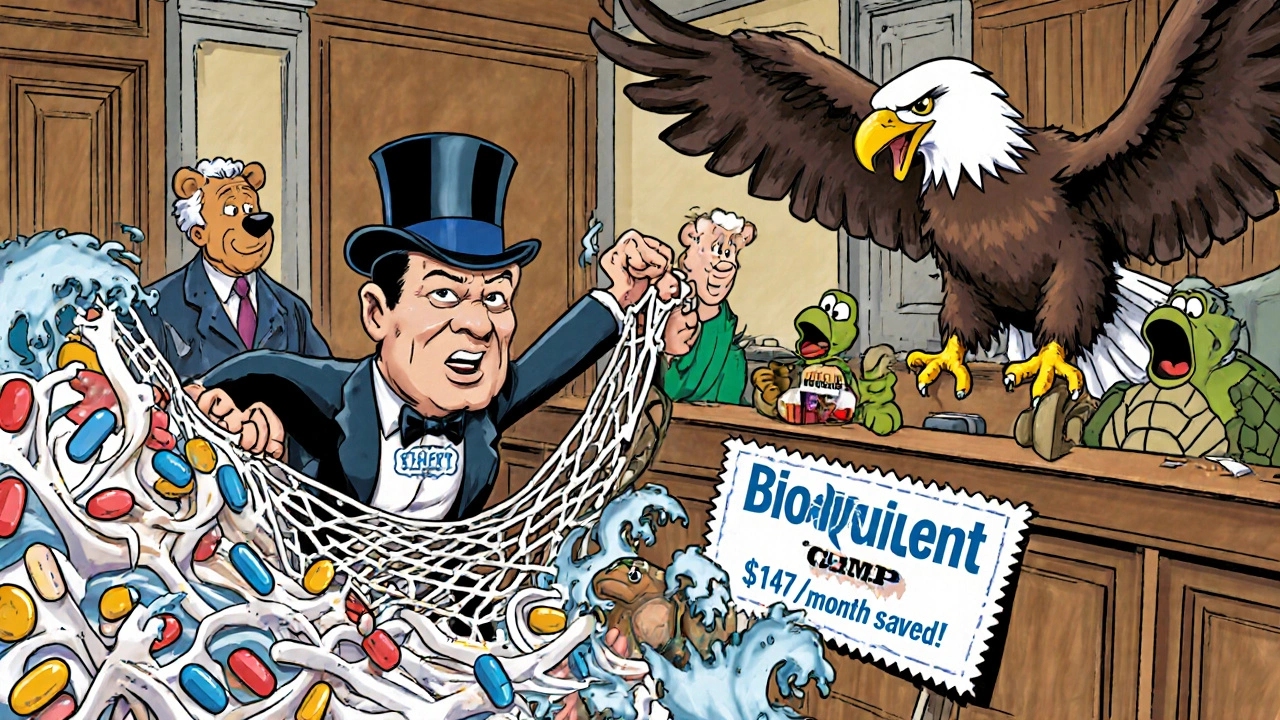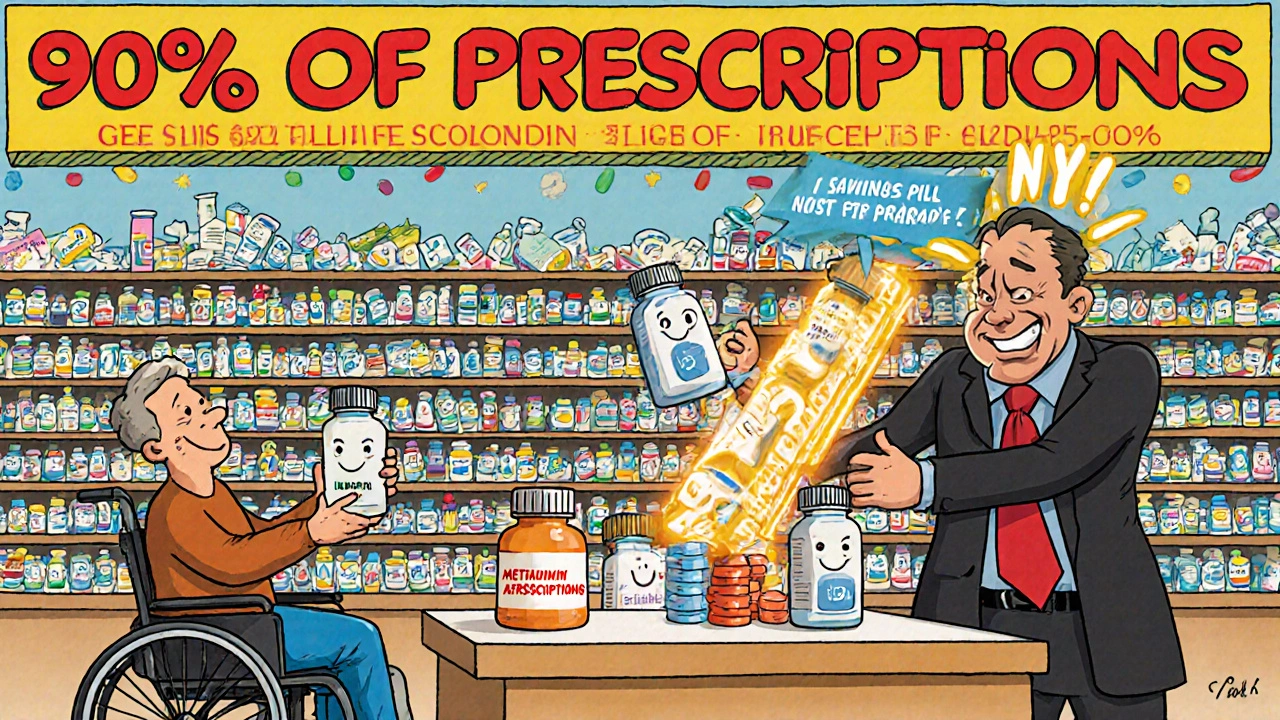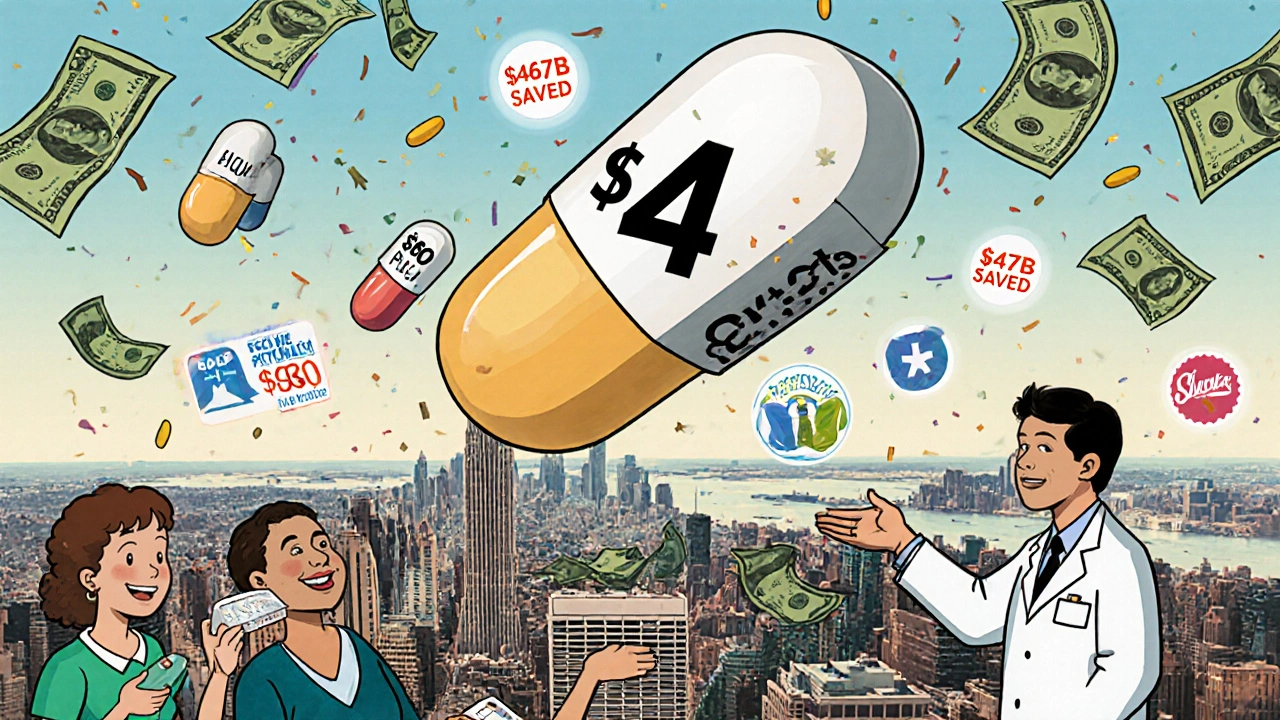Every year, Americans fill over 3.9 billion prescriptions for generic medicines. That’s nine out of every ten prescriptions written. And yet, these drugs make up just 12% of total prescription spending. How is that possible? Because generics aren’t just cheaper-they’re a financial lifeline for the entire U.S. healthcare system. In 2024 alone, generic and biosimilar drugs saved the system $467 billion. Over the last decade, that number hit $3.4 trillion. That’s not a typo. Trillions. And it’s all happening quietly, in the background, while most people barely notice the difference between a brand pill and its generic copy.
How Generics Cut Costs So Deeply
The secret isn’t magic. It’s competition. When a brand-name drug’s patent expires, other companies can legally make the exact same medicine. No need to redo clinical trials. No need to spend millions on ads. They just copy the formula, get FDA approval, and sell it for a fraction of the price. The first generic maker usually gets a 180-day head start, but soon, five, ten, even twenty companies start making it. Prices drop fast. A drug that cost $100 a month as a brand might cost $4 as a generic. Sometimes less. In 2024, Americans spent $98 billion on generic prescriptions. Meanwhile, brand-name drugs cost $700 billion-even though they were prescribed only 435 million times. That’s a 16-to-1 cost gap for the same treatment. The same pattern holds for biosimilars, which are generic versions of complex biologic drugs like Humira or Enbrel. In 2024, biosimilars saved $20.2 billion in just one year. Since 2015, they’ve saved $56.2 billion. And they’re still just getting started.Who’s Really Saving Money?
It’s not just patients. It’s Medicare, Medicaid, insurers, employers, and taxpayers. In 2024, generics saved Medicare $142 billion. Medicaid saved $62.1 billion. Blue Cross Blue Shield saved billions more through formulary design that pushed patients toward cheaper options. Even private insurers saw their drug costs shrink because generics kept overall spending in check. But here’s the thing: patients feel it most at the pharmacy counter. A 2023 survey found that 89% of people who switched from brand to generic reported being satisfied with both the cost and effectiveness. The average monthly savings? $147 per medication. That’s over $1,700 a year for one drug. For someone on three generics? That’s more than $5,000 saved annually. For seniors on fixed incomes, that’s food, rent, or heating bills.The Top Savings Drivers
Not all generics save the same amount. The biggest wins come from drugs that treat the most common chronic conditions-and those that used to cost a fortune. In 2024, the top 10 generic therapeutic classes saved $216.5 billion. That’s almost half of all generic savings. These include:- High blood pressure meds (like lisinopril and amlodipine)
- Cholesterol drugs (atorvastatin, simvastatin)
- Diabetes treatments (metformin)
- Antidepressants (sertraline, fluoxetine)
- Acid reflux meds (omeprazole)
Why the U.S. Leads the World in Generic Use
The U.S. fills 90% of prescriptions with generics. Most European countries? 60% to 80%. Why the gap? It’s not because Americans are more savvy. It’s because the system was built for it. The 1984 Hatch-Waxman Act created the legal pathway for generics. It balanced patent protection for innovators with a clear route for competitors to enter. It gave the FDA authority to approve generics quickly if they proved bioequivalence. Other countries didn’t build that infrastructure the same way. Some still require extra testing. Some let brand companies delay generic entry through legal tricks. The result? The U.S. has the most competitive generic market on Earth. And it’s paying off-literally.
The Hidden Barriers to Even More Savings
Here’s the uncomfortable truth: the system works… but it’s being sabotaged. Brand drug makers don’t just wait for patents to expire. They use legal and financial tricks to keep generics out longer. One tactic? Patent thickets. That’s when a company files dozens of minor patents on a single drug-covering everything from pill shape to manufacturing process-to block generics. A 2024 study found that just four drugs had patent thickets that cost the system over $3.5 billion in two years. Another? Pay-for-delay. Sometimes, brand companies pay generic makers to hold off on launching their cheaper version. In 2023, these deals cost the system nearly $12 billion a year-$3 billion of it paid by federal programs. Then there’s product hopping. A company slightly changes a drug’s formula or delivery method (say, from a pill to a capsule), gets a new patent, and pressures pharmacies to switch patients. The old generic? Now it’s off the market. The new version? Still expensive. And it’s not just the drug companies. Pharmacy Benefit Managers (PBMs)-the middlemen who negotiate drug prices for insurers-sometimes push patients toward more expensive brands because they get bigger rebates. Prior authorization rules for generics have jumped 47% since 2019, making it harder for doctors to prescribe them.State-Level Differences Matter
Savings aren’t the same everywhere. California saved nearly $38 billion in 2023. Alaska? Just $600 million. Why? Population size plays a role, but policy matters more. California mandates pharmacists to substitute generics unless the doctor says no. That’s called mandatory substitution. It pushed generic use to 98%. Texas, with more flexible rules, sits at 87%. States with strong substitution laws consistently save more. Some states also run their own generic discount programs. In New York, Medicaid patients can get certain generics for $1. In Vermont, a state-run pharmacy buys generics in bulk and sells them directly to residents at low prices.What’s Next? More Generics, More Challenges
The FDA approved 1,145 new generic drugs in 2024-up 7.3% from the year before. Many are complex: injectables, inhalers, and specialty oral drugs. Another $24 billion in brand drug spending is expected to go generic by 2025. That’s a massive wave of savings on the horizon. Biosimilars are accelerating too. The market grew 22.7% last year and is projected to keep growing through 2029. Drugs like Humira, which cost over $2,000 a month, now have multiple biosimilar options under $500. That’s a game-changer for autoimmune patients. But threats remain. Drug shortages hit 287 generic medications in late 2024. Many are made overseas, and supply chains are fragile. Also, the market is consolidating. The top 10 generic manufacturers now control 63% of the market-up from 51% in 2015. Less competition means less pressure to lower prices.
The Bigger Picture
The U.S. spends $4.9 trillion on healthcare every year. Prescription drugs make up about 10% of that-$490 billion. Generics keep that number from exploding. Without them, drug spending could easily hit $1 trillion. That would mean higher premiums, bigger copays, and more people skipping meds. Experts agree: enhancing generic competition is one of the most cost-effective ways to control healthcare costs. As Dr. A. Mark Fendrick from the University of Michigan says, “Leveraging generics is critical for creating the financial headroom needed to afford innovative new products.” But we can’t just celebrate savings. We have to protect them. That means supporting laws like S.1041, which targets patent abuse. It means pushing PBMs to stop steering patients away from generics. It means state lawmakers adopting mandatory substitution. Because the next trillion-dollar savings isn’t coming from a new miracle drug. It’s coming from a pill you can buy for $4 instead of $800.What Patients Should Know
If you’re on a brand-name drug, ask your doctor: “Is there a generic?” If you’re told no, ask why. Sometimes it’s because the brand has special packaging or delivery. But often, it’s just inertia-or a formulary quirk. Check your insurance plan’s formulary. Some plans still list generics as Tier 3 or 4, meaning higher copays. That’s outdated. Most generics should be Tier 1-lowest cost. And if you’ve had a bad experience with a generic-say, it didn’t seem to work as well-talk to your pharmacist. Sometimes, different manufacturers use slightly different fillers or coatings. Switching brands within generics can help. Don’t assume the generic doesn’t work. Just ask for a different one.Final Thought
The healthcare system isn’t broken because it’s too expensive. It’s broken because we don’t use the tools we already have. Generics are proven, safe, and wildly effective. They’ve saved trillions. They’re saving billions every year. And they’re still saving more. The question isn’t whether we can afford generics. It’s whether we can afford not to use them.Are generic drugs as safe and effective as brand-name drugs?
Yes. The FDA requires generics to have the same active ingredients, strength, dosage form, and route of administration as the brand-name drug. They must also meet the same strict standards for purity, stability, and performance. Over 90% of generics are rated as therapeutically equivalent. While some patients report minor differences in side effects or how quickly the drug works-often due to inactive ingredients like fillers-these are rare and usually not clinically significant. If a generic doesn’t seem to work, switching to another manufacturer’s version often resolves the issue.
Why do some pharmacies charge more for generics than others?
Prices vary because pharmacies buy generics from different distributors, and pricing isn’t regulated at the retail level. Some pharmacies negotiate bulk deals. Others charge more because they’re in high-rent areas or have higher overhead. Medicare Part D and private insurers often have preferred pharmacies with lower generic prices. Always compare prices-sometimes paying cash at a discount pharmacy like Walmart or Costco is cheaper than using insurance. The average generic cost at a major chain is $4-$10 for a 30-day supply.
Do biosimilars save as much as regular generics?
Biosimilars don’t save as much per unit as regular generics, but they’re still massive savings overall. While a typical generic might cost 80-95% less than its brand, biosimilars usually cost 15-35% less. That’s because biologics are complex proteins made from living cells, not simple chemical formulas. Still, when you’re talking about drugs that cost $2,000-$10,000 a month-like those for rheumatoid arthritis or cancer-15% savings means thousands per patient per year. Since 2015, biosimilars have saved $56.2 billion in the U.S., and that number is growing fast.
Why don’t doctors always prescribe generics?
Sometimes, it’s habit. Many doctors were trained to prescribe brand names and may not be aware of the latest generic options. Other times, it’s because the brand has special features-like extended-release formulations or combination pills that don’t yet have generic equivalents. Insurance formularies can also influence prescriptions: if a brand is on Tier 1 but the generic is on Tier 3, the doctor might pick the brand to avoid patient cost shocks. Always ask: “Is there a generic?” and “Will my insurance cover it at a lower cost?”
Can I switch from a brand to a generic without my doctor’s approval?
In most cases, yes-thanks to state substitution laws. Pharmacists can switch a brand prescription to a generic unless the doctor specifically writes “Dispense as Written” or “Do Not Substitute.” If you’re paying out of pocket and the generic is cheaper, you can ask the pharmacist to switch it even if your insurance doesn’t require it. If you’re on Medicaid or Medicare, substitution is often automatic. Always check with your pharmacist before picking up your prescription to confirm what you’re getting.
What’s being done to prevent drug companies from blocking generics?
Federal agencies are cracking down. The FTC and DOJ have increased scrutiny on pay-for-delay deals and patent thickets. In 2024, the Senate HELP Committee passed S.1041, the Affordable Prescriptions for Patients Act, which would make it harder for brand companies to abuse the patent system. The FDA has also started publishing a list of drugs with patent issues to alert generic manufacturers. These efforts aim to reduce delays and restore competition. If passed into law, the bill could save an additional $7.2 billion per year.

Manish Pandya
November 24, 2025 AT 20:28Just had to say this - I’ve been on generic metformin for 8 years, and my blood sugar’s never been better. My pharmacist even told me the fillers are the only difference, and sometimes switching brands fixes weird side effects. Seriously, if you’re scared of generics, try a different maker before giving up on them.
Lawrence Zawahri
November 25, 2025 AT 01:14TRILLIONS? LOL. You think this is about savings? Nah. This is Big Pharma’s cover-up. The FDA’s in their pocket. Those ‘bioequivalent’ generics? Half of them are made in China with expired chemicals. Your ‘$4 pill’ is just a placebo with a different color. Wake up, sheeple. The real drug crisis is the one they’re feeding you.